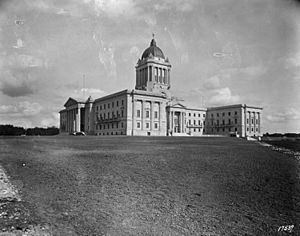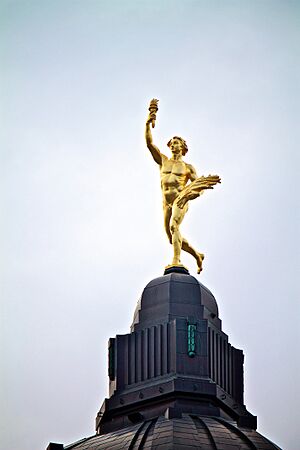Golden Boy (Manitoba) facts for kids
Quick facts for kids The Golden Boy |
|
|---|---|
| Eternal Youth and the Spirit of Enterprise | |
 |
|
| Artist | Georges Gardet |
| Year | 1918 |
| Medium | Gilded bronze statue |
| Dimensions | 525 cm (207 in) |
| Weight | 1,650 kg |
| Location | Manitoba Legislative Building, Winnipeg, Manitoba |
The Golden Boy (officially called Eternal Youth and the Spirit of Enterprise) is a famous statue that looks north from the top of the Manitoba Legislative Building in Winnipeg, Manitoba, Canada. It's a well-known symbol for the province. The statue looks like the Roman god Mercury, who was a messenger. It stands for Manitoba's success and its spirit of starting new businesses.
This impressive statue weighs about 1,650 kilograms (that's over 3,600 pounds!). From its toes to the top of its torch, it's 5.25 meters (about 17 feet) tall. When it was first put up, the tip of its torch was the highest point in all of Winnipeg, reaching 77 meters (about 250 feet) above the ground. The Golden Boy has been on top of the building since it opened, except for a few months in 2002 when it was taken down for repairs and to be regilded (covered in new gold).
Contents
History of the Golden Boy
Why the Statue Was Built
The idea for the Golden Boy came from a British architect named Frank Worthington Simon. He also designed the Manitoba Legislative Building where the statue would sit. This was during World War I, a very important time in history.
In the late 1800s, the Canadian Pacific Railway started to open up Western Canada. This led to many immigrants moving to places like Winnipeg. By 1911, Manitoba's population had grown a lot. The province had many natural resources, and Winnipeg was a busy center for farming and trade. Because of this growth, the Government of Manitoba decided to build a new, grand legislative building. They wanted it to show Manitoba's new strength and energy. Simon's design was chosen because it aimed to create an inspiring building, with the statue as its most important feature at the very top.
How the Statue Was Made
In 1915, Simon asked a sculptor from Paris, Georges Gardet, to create the statue. For about 18 months, they sent letters and drawings back and forth across the Atlantic Ocean. These old documents are now kept safe at the Archives of Manitoba.
Simon planned for the statue to be built in two parts. The top part, including the statue itself, would be made in France. The bottom part of the support would be made in Winnipeg after the statue arrived. It was hard to get materials like metal because of the war. Simon explained in 1917 that it was "impossible to obtain [the shaft] either in England or in France." So, the upper support was made in Chicago and then sent to France. Simon also wanted the statue to be cast as one solid piece. But because metal was scarce in France, it had to be made from several smaller pieces.
The Government of Manitoba bought the statue from France. Gardet finished it in 1918. It was cast in bronze by the Barbedienne Foundry, even though the foundry was bombed during the war.
The Golden Boy's Journey to Canada
After it was finished and still in one piece after the bombing, the statue was put into the cargo hold of a freight ship to be sent to Canada. But the ship was then used for the war! It was ordered to carry allied troops and supplies. So, the statue stayed on the ship for the rest of the war. It made two long trips across the Mediterranean Sea and five trips across the Atlantic Ocean.
Finally, the statue arrived in Halifax, Nova Scotia. From there, it traveled by train to Winnipeg. On November 21, 1919, the Golden Boy was placed on top of the Manitoba Legislative Building. This was just in time for the building's official opening in 1920.
Even though the statue was made of bronze, people started calling it the 'Golden Boy' right away. This was because the new bronze statue shone brightly in the sun, making it look like it was made of gold. The total cost to design, create, transport, and lift the statue was about CA$13,240.73.
Repairs and Updates
In the 1940s, the bronze statue was painted gold. Then, in 1951, it was covered with real gold leaf for the first time. About 50,000 square inches of 23.5-karat gold leaf were used. In 1966, an electric lamp was put on top of the statue's torch. It was first lit on December 31, 1966, to celebrate Canada's 100th birthday in 1967.
By 2002, the statue needed repairs. Rust was building up inside the hollow statue, and its iron supports were wearing away. A company called Alpha Masonry carefully lowered the statue to the ground for a full repair and to be regilded. On February 9, 2002, the Golden Boy was back on the ground in a special aluminum cage. It had been on top of the building for almost 83 years!
In August 2002, the statue was covered again with a very thin layer of 23.75-karat gold leaf. This was done in a special, climate-controlled area where the public could watch. During the repairs, the statue was also shown at the Manitoba Museum and the Forks National Historic Site. A new steel support was put in, along with a system to check its health. This system uses monitors to measure things like vibrations, wind stress, and how temperature affects the statue.
The Golden Boy was put back on the Legislative Building on September 5, 2002. Queen Elizabeth II, as Queen of Canada, rededicated it during her 2002 Golden Jubilee tour of Canada the next month. The whole repair project cost about CA$1.1 million. The gold leaf itself cost $5,600.
The new gold is expected to last for about 25 to 30 years. Since its repair, the Golden Boy's torch is no longer lit by an electric light. This is because the old electrical cord was one reason for the rust found in 2002. Now, bright floodlights shine on the torch at night.
What the Golden Boy Represents
The Golden Boy statue is based on a 16th-century sculpture of Mercury, the Roman god of trade and business. The sheaf of wheat in the statue's left arm shows the rewards of hard work. The torch in its right hand encourages young people to keep working towards a better future. The statue faces north, pointing towards the northern parts of Manitoba. This symbolizes how important that region is for natural resources and economic chances.
There's even a traditional fiddle tune called "Manitoba Golden Boy" that honors the statue. Part of the song says:
He’s the symbol of success
At the gateway to the west
And he’s our legendary pride and joy.




